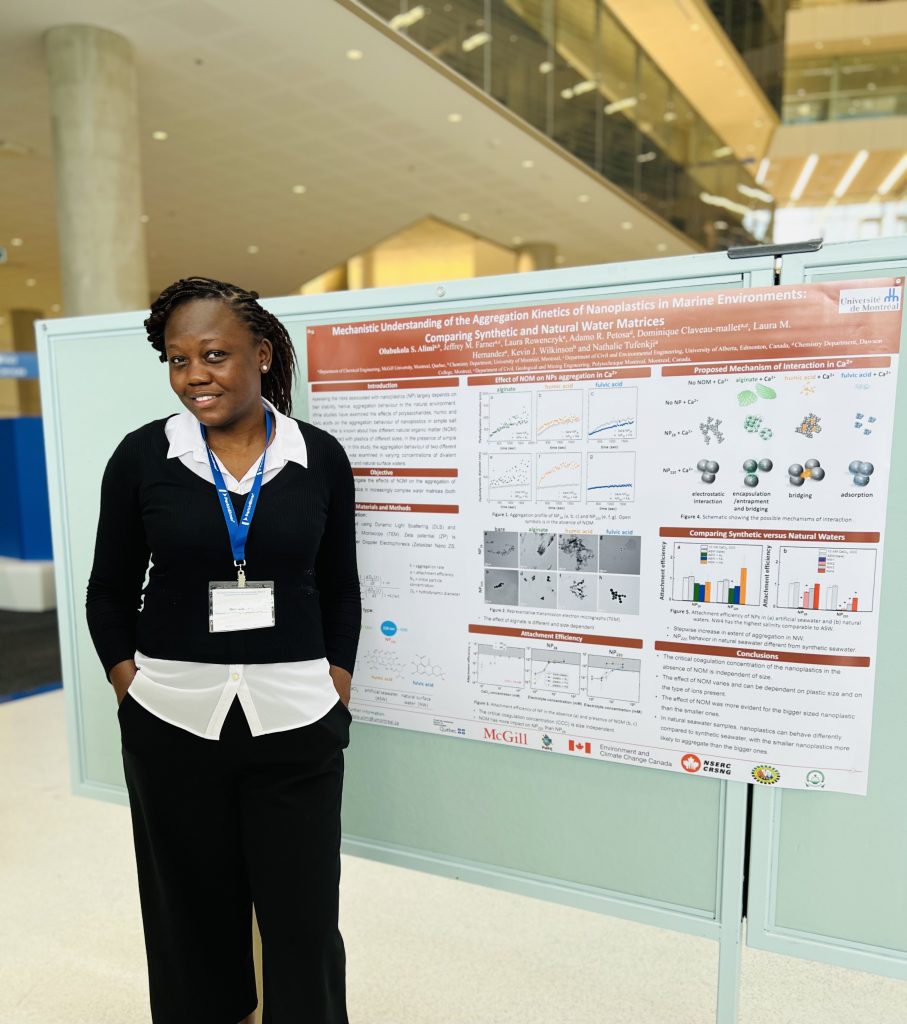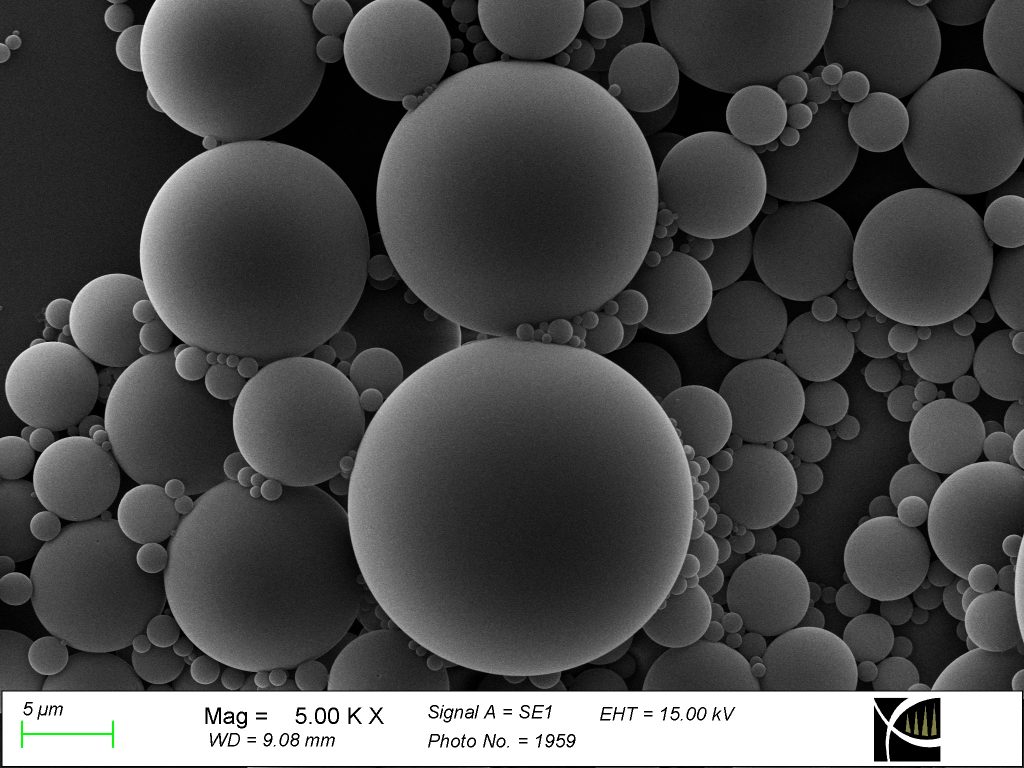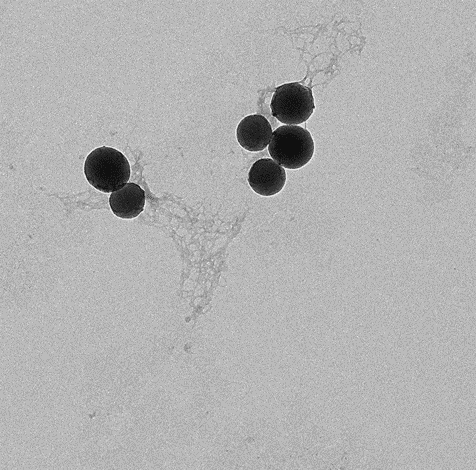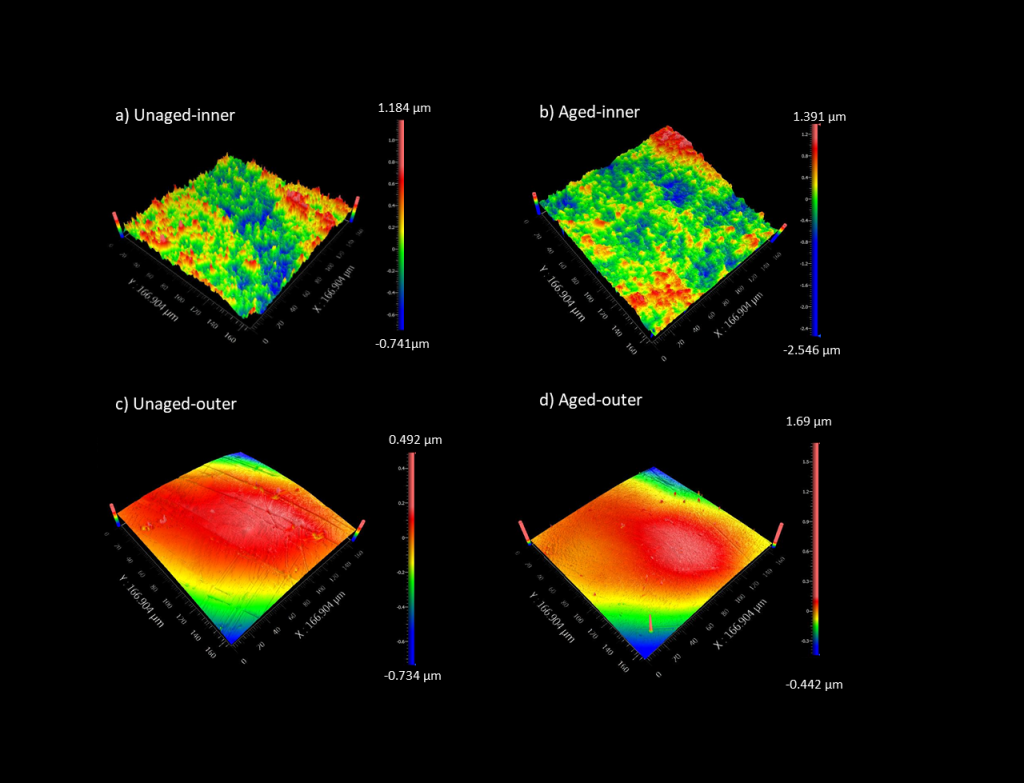What happens when plastics break down into microplastics and nanoplastics?
Microplastics and their even smaller cousins, nanoplastics, are a growing concern for environmental and human health. At the FAMU-FSU College of Engineering in Florida, USA, and the University of Alberta in Canada, environmental engineers Dr Jeffrey Farner and Dr Olubukola Alimi are studying what happens as plastics degrade into microplastics and nanoplastics, and how this pollution interacts with other substances.
Talk like an environmental engineer
Adsorb — to stick to the surface
Brownian motion — the continual random motion of particles in a fluid due to the constant movement of atoms
Colloid — a suspension of particles that are too small to settle out on their own
Microplastic — a small piece of plastic debris (<5 mm)
Nanoplastic — an even smaller piece of plastic debris (<0.001 mm)
Plastic polymer — a molecular chain formed of repeating units of carbon and hydrogen
Weathering — the physical and chemical transformation and breakdown of a substance
Plastic pollution is a pressing global issue. Less than 10% of plastic ever produced has been recycled, and many million tonnes of plastic waste have entered the environment. While images of turtles choking on plastic bags send a powerful message about the dangers of plastic pollution, some of the consequences are much less visible, but just as concerning.
When plastic breaks down into tiny pieces, it begins interacting with the environment in new and troubling ways. At the FAMU-FSU College of Engineering and the University of Alberta, Dr Jeffrey Farner and Dr Olubukola (Bukola) Alimi are investigating the changes that occur as plastic degrades. Worryingly, scientists have discovered that plastic pollution now exists in every part of the planet, found in sea creatures living in the deepest and remotest depths of the ocean and in drinking water around the world.
How are microplastics and nanoplastics formed?
Like any material, plastics degrade over time. Sunlight, heat, and the action of water, sand and microorganisms all physically and chemically break plastics down. “If you’ve ever picked up an old plastic bag and had it fall apart, you’ve seen how weathering impacts plastic,” says Jeff. “As plastic is weathered, the surface undergoes chemical changes, it becomes brittle and small particles break off.” These particles are known as microplastics (when <5 mm) and nanoplastics (when <0.001 mm).
What are the effects of microplastics and nanoplastics?
“In general, bulk plastic is a safe material – it’s one of the reasons why we use it for so many applications,” explains Bukola. “However, when plastic particles approach the nanoscale, they can move across biological barriers.” This means if you ingest nanoplastics by drinking water or eating meat containing them, the tiny plastic particles can pass through your intestinal walls and enter your bloodstream. “We’re seeing this happen in animals, including humans, but we don’t yet know the health implications,” says Bukola.
Jeff and Bukola are concerned about the impacts of low concentrations of microplastics and nanoplastics in the environment over long periods of time. As this pollution is now everywhere, any negative impacts could have severe consequences for ecosystems. “For instance, nanoplastics might impact reproductive success over multiple generations,” says Jeff. “Or exposure to nanoplastics might make organisms more susceptible to other toxic substances.”
Why does size matter?
As you break something into smaller pieces, you increase its total surface area. For example, a plastic cube of 1×1×1 cm has a volume of 1 cm3 and surface area of 6 cm2. If you cut this cube into a thousand cubic millimetres, the total volume will stay the same, but the total surface area will increase to 60 cm2. By the time the piece of plastic has weathered into trillions of nanoplastic particles, its surface area will be over a million times greater. This means there is significantly more plastic surface for reactions to take place on and more sites for other substances, such as toxins, to adsorb to.
The tiny size and large surface area of nanoplastics means they have some unusual physical and chemical properties. In water, nanoplastics form a colloid – a suspension of particles that are small enough to remain in suspension indefinitely. “Milk is a great example of a colloid,” says Bukola. “It is a suspension of fat and protein molecules in water.” Once nanoplastics enter water, they do not settle out on their own and so they can travel great distances from their source.
How do Jeff and Bukola study something so small?
“Nanoparticles are too small to see under a regular microscope,” explains Jeff. “However, if we shine a laser at a colloidal suspension of nanoplastics, the light will be scattered.” This process, known as dynamic light scattering, allows Jeff and Bukola to determine the size of the particles they are studying. Brownian motion causes the particles in the suspension to constantly move, but larger particles will move more slowly while smaller particles will move more quickly. “We look at how the scattered light changes to understand how big our plastic particles are,” explains Jeff.
What have Jeff and Bukola discovered?
“Weathering not only decreases the size and increases the surface area of plastics, it also oxidises them,” explains Jeff. When oxygen is added to the plastic polymer, it causes chemical and physical changes to the plastic. “This means weathered plastics can behave very differently from the original plastic,” says Jeff. “This makes studying plastics interesting, because you need to consider the starting material and the weathering process to understand microplastics and nanoplastics.”
As plastics are weathered to microplastics and nanoplastics, the changes in surface properties are of particular concern. “The particles often become more negatively charged, which makes them more stable in water,” explains Bukola. “It also causes other compounds to adsorb to the surface of the plastic. While the nanoplastic itself might not be toxic, the substance attached to it might be.” For instance, if a nanoplastic adsorbs a toxic metal particle then enters an animal’s bloodstream, it will carry the toxic metal with it.
In this way, nanoplastics are not only contaminants themselves, but are also carriers of other contaminants. “The question is, which is the bigger concern?” asks Jeff. “And what does this mean for the environment?” Jeff and Bukola hope that their research will help answer these crucial questions and provide evidence about the risks associated with microplastics and nanoplastics. Plastic pollution has never been a more pressing issue, and understanding its impacts will encourage consumers and policymakers to rethink our unsustainable relationship with plastics.
Reference
https://doi.org/10.33424/FUTURUM493
(doi.org/10.1016/j.hazadv.2022.100115)
 Dr Jeffrey Farner
Dr Jeffrey Farner
Department of Civil and Environmental Engineering, Florida A&M University – Florida State University (FAMU-FSU) College of Engineering, USA
Department of Civil and Environmental Engineering, University of Alberta, Canada
Dr Olubukola Alimi
Department of Civil and Environmental Engineering, University of Alberta, Canada
Fields of research: Environmental engineering, environmental chemistry
Research project: Studying the release, transport and fate of microplastics and nanoplastics
Funders: Natural Sciences and Engineering Research Council of Canada (NSERC), Environment and Climate Change Canada, Alberta Conservation Association
About environmental engineering
Environmental engineering incorporates knowledge and techniques from across science and engineering to address environmental challenges in the world. The breadth of these challenges leads to a diverse field, with environmental engineering careers in areas such as air and water quality management, waste management, pollution control and climate change mitigation.
What challenges are environmental engineers addressing?
“One of the greatest challenges is figuring out how we can maintain a healthy environment, despite our constant need to use it,” says Jeff. “For instance, we’re always going to need water – for drinking, agriculture and industry. How do we use this precious resource wisely?” Addressing the challenge of water scarcity and quality involves finding new ways to reuse wastewater, keep water clean and use it more efficiently.
“The next generation of environmental engineers will be tasked with addressing a myriad of challenges,” says Bukola. “Emerging contaminants (which include pharmaceuticals, pesticides and nanomaterials) are of particular concern, because they release into our lands, air and water and have the potential to harm ecosystems and humans.” Solving the issue of contaminants requires innovative and collaborative environmental engineers who will develop technologies and industrial processes that result in a cleaner and more sustainable environment.
“There is increasing pressure on our natural resources,” says Bukola. “We need people who are passionate about addressing these challenges. You should be excited about pursuing a career in environmental engineering because it will allow you to protect the environment and improve people’s everyday lives.”
Pathway from school to environmental engineering
At school, studying chemistry and mathematics will give you a strong foundation for pursuing further studies in environmental engineering. Biology and physics would also be useful.
At university, a degree in environmental engineering, another engineering field, chemistry or environmental science could lead to a career in environmental engineering.
Jeff and Bukola recommend taking chemistry and statistics courses alongside engineering courses in topics such as thermodynamics and fluid mechanics. “These will equip you with knowledge of chemical reactions and tools to design systems to solve environmental problems,” says Bukola.
“It is wonderful that environmental engineering covers such an enormous range of topics, because anyone can find their passion somewhere under that giant umbrella,” says Jeff. This means you can customise your courses to align with your interests, whether that is in water resource engineering, solid waste management, environmental policy, air or water quality, or site remediation.
Explore careers in environmental engineering
“There are so many careers available in environmental engineering,” says Jeff. “From water and wastewater engineers, to analytical chemists testing water quality, to microbiologists looking for new ways to clean contaminated sites – the list goes on and on.”
Other roles include policymakers, environmental consultants, data analysts and science communicators. “We need more people who are skilled at communicating research with the public,” says Jeff. “It is crucial for society to understand what we are doing and why, and to appreciate and embrace new technologies.”
The Challenger Learning Center is the outreach facility of the FAMU-FSU College of Engineering. It runs a wide range of activities for high school students, including a broad range of summer camps covering areas from engineering through to science communication: www.challengertlh.com
The University of Alberta’s Women in Scholarship, Engineering, Science and Technology programme offers summer research programmes for students and allows them to unleash their curiosity by participating in hands-on STEM activities: www.ualberta.ca/women-in-scholarship-engineering-science-technology/index.html
Meet Jeff
As a teenager, my interests were music, soccer and reading. I still enjoy them today – music provides the soundtrack to my days, and I play soccer while travelling. These days, I read more scientific articles than books, but I still firmly believe that reading is an amazing way to explore the world.
As an undergraduate student, my favourite courses were analytical chemistry and environmental chemistry. I liked understanding how instruments worked and how chemistry could be applied to the outdoor world.
My first job was as an analytical chemist for the State of Iowa. I tested drinking water for the presence of pesticides. It felt good to ensure that people’s water was safe, but I didn’t like the fact that my part in the process ended once I had reported the presence of pesticides. I wanted to protect and restore water supplies rather than just point out the problems. This motivated me to go to graduate school to study environmental engineering.
A key challenge in engineering is to not only work out what’s possible, but what’s feasible. If you have a solution to a problem but it’s very expensive, or you can’t convince people that it’s safe, then it’s not going to happen. Research is often focused on figuring out what’s possible and it’s easy to forget the feasibility side. But it’s necessary if you want to see your solutions in the real world.
I firmly believe that ‘outside is the best side’. If I can be outside, I know I’ll have a nice time, regardless of weather. This can be cycling, hiking or cross-country skiing in the winter. Just being surrounded by nature with my family and friends recharges my battery.
Jeff’s top tips
1. Find the thing that interests you. If you’re curious to learn more, dive in! Many people giving career advice will tell you, “I didn’t have a real plan, I was just interested and kept going.”
2. Don’t be afraid to try new things. Maybe you get an opportunity to study abroad or to work somewhere that you don’t feel qualified for – if you’re interested and excited, take that chance.
Meet Bukola
When I was younger, I was passionate about basketball – it was a great stress reliever and brought a lot of fulfilment. My family also gave me a deep love of reading. It was our family tradition that my dad always bought newspapers, even if it meant spending his last kobo (Nigerian currency). We all took it in turns to read the newspapers, which exposed me to a wide range of topics and gave me an awareness of events in the world around me.
Growing up in the oil-rich Delta State of Nigeria, I was confronted with many environmental issues, from gas flaring to oil spillage to mismanaged waste. I had a strong yearning to see positive changes, which inspired my passion for environmental engineering.
I originally trained as a chemical engineer but have consistently found myself drawn to the environmental side of the field. My journey towards environmental work began during an undergraduate internship at a water treatment facility with Chevron Nigeria. Since then, I have made deliberate efforts to explore practical solutions to environmental pollution, especially concerning water quality.
The most rewarding part of my work is knowing that I contribute to the global efforts aimed at solving some of the environmental problems we face today. It’s refreshing to identify a problem or knowledge gap that affects many people in their everyday lives and work towards addressing it.
Maintaining a good work-life balance is my priority. I enjoy going to the gym, doing long hikes on Saturday mornings, and watching documentaries. I’ve also recently started practising meditation, which helps my mental health and overall well-being.
Bukola’s top tips
1. Find your motivation and hold on to the reason(s) why you want to achieve something. My journey hasn’t been easy, but it has been rewarding, and motivation helped me focus on the big picture whenever I felt lost.
2. Seek out mentors who have travelled the road you hope to take. Talk to them, hear their stories, ask questions and be inspired.
Do you have a question for Jeff or Bukola?
Write it in the comments box below and Jeff or Bukola will get back to you. (Remember, researchers are very busy people, so you may have to wait a few days.)
3 Comments
Submit a Comment
Plastics, microplastics and nanoplastics have a significant environmental impact. Discover how biological engineers are developing sustainable plant-based plastic alternatives:
www.futurumcareers.com/plant-polymers-as-plastic-alternatives












Hello to both of you and thank you so much for focusing so much work on this incredibly important subject! For me, what you are doing is literally heroic.
I am a Yale grad and currently working on a fictional writing project in which the micro and nanoplastic pollution play an important part. As part of my research, I would love to ask you a series of questions and would happily give thanks to you in a forward to the piece and respectfully cite any and all of your work. I promise not to inundate you.
I’m happy to send you these questions by email, should you provide it, and you may decide to respond at your earliest convenience.
All the best and my children thank you for your work, as well.
Hi Joe, Thanks for your interest in our research! Happy to chat. My email is jfarner(at)eng.famu.fsu.edu
Hi, I’m really happy to read your research about the plastics. It reallly helps me knowing to take care about our environment. May I get more informations about your further researches?